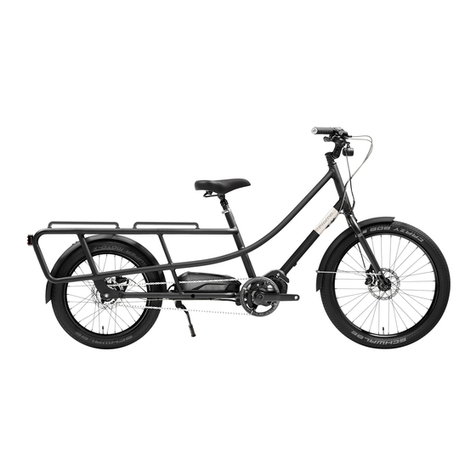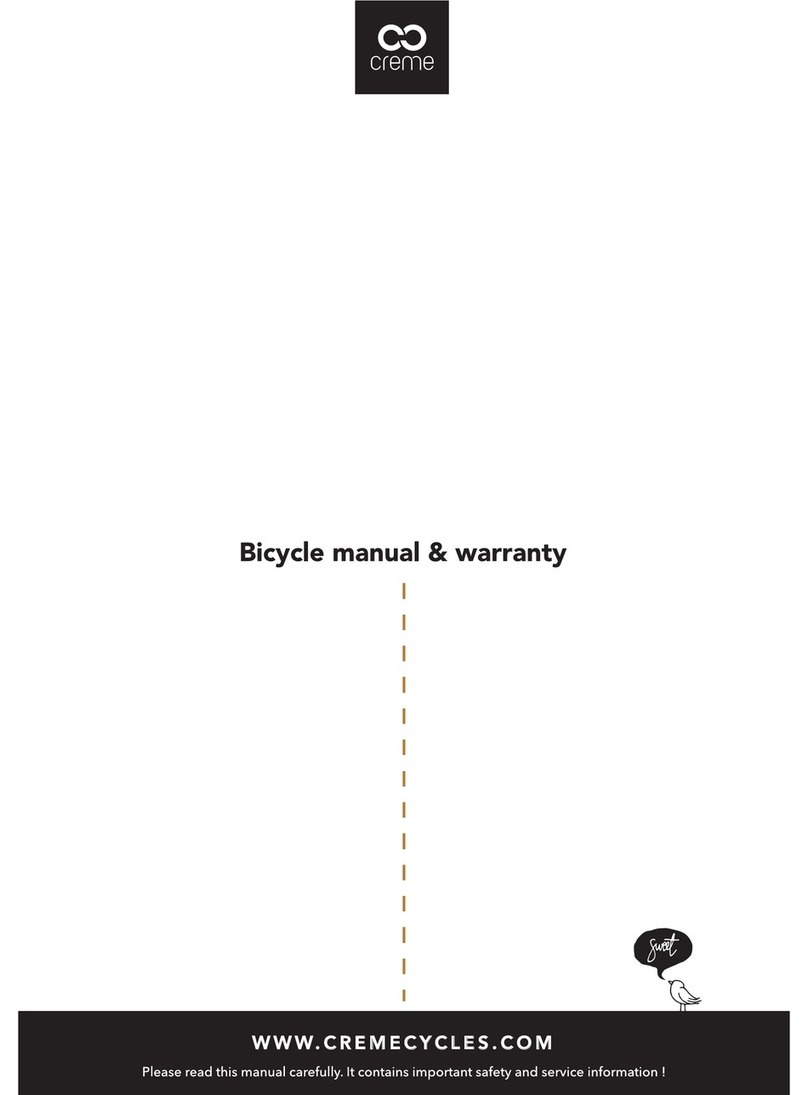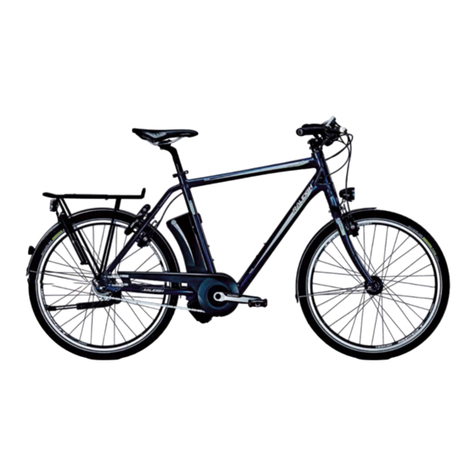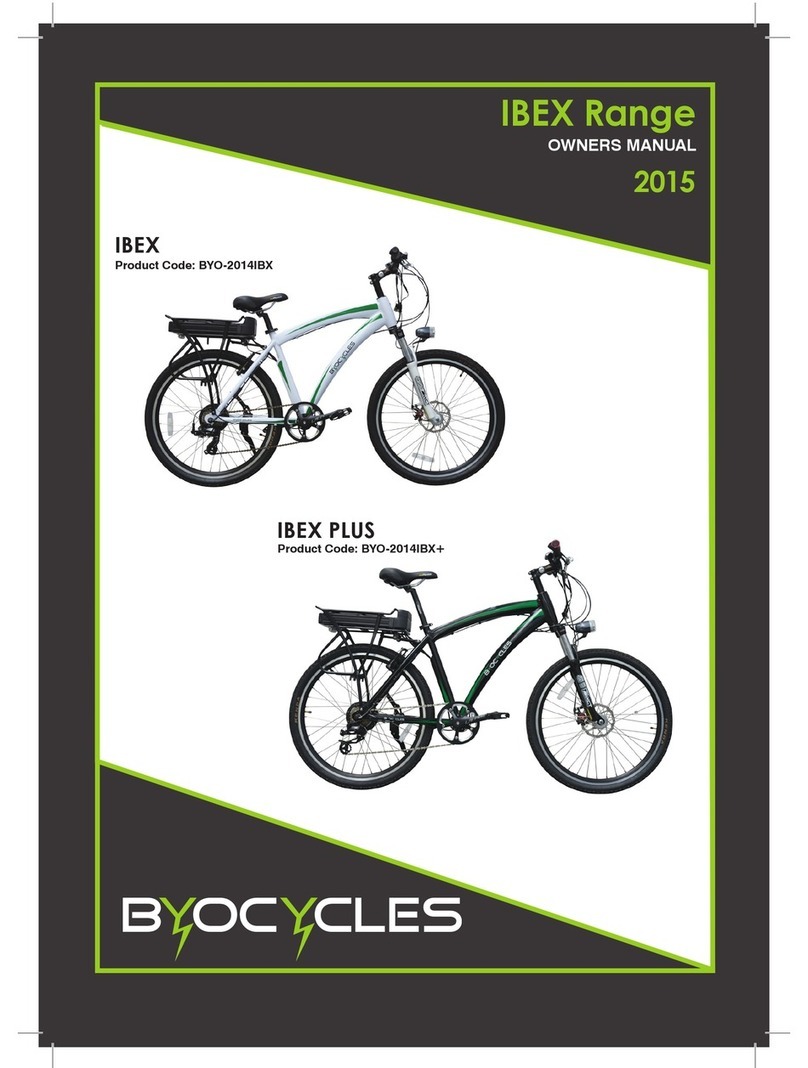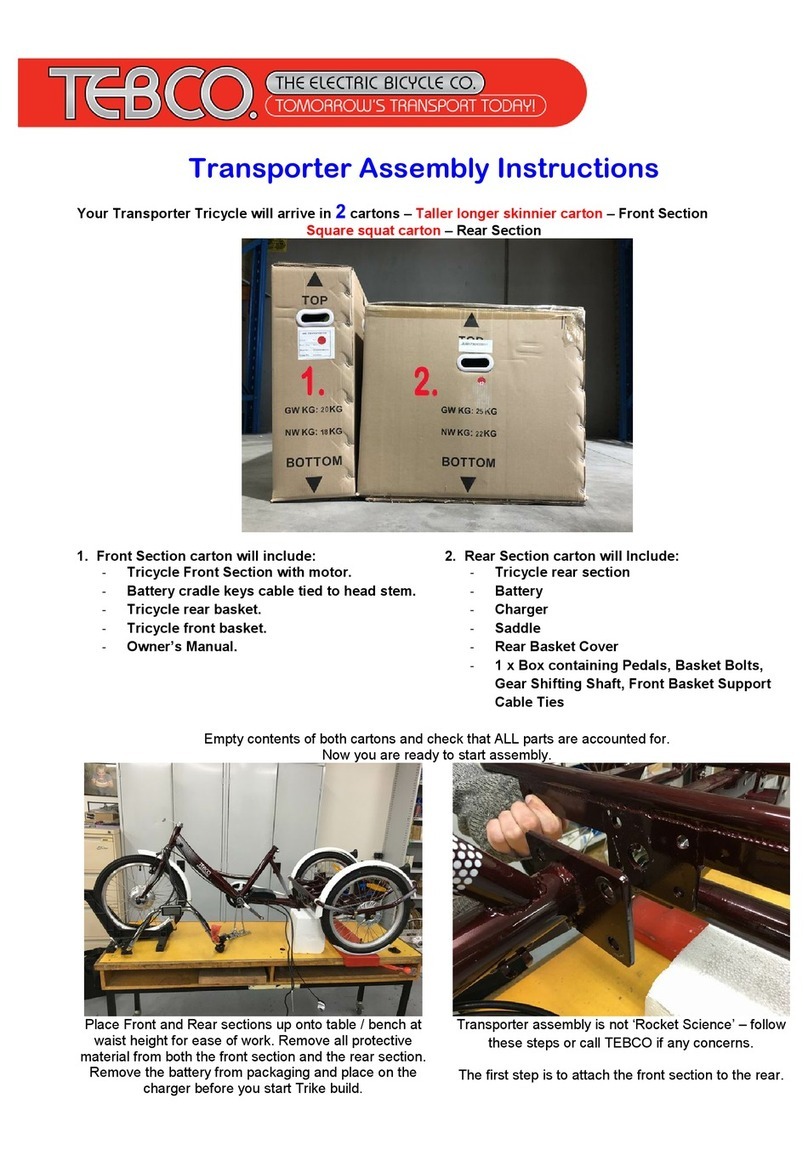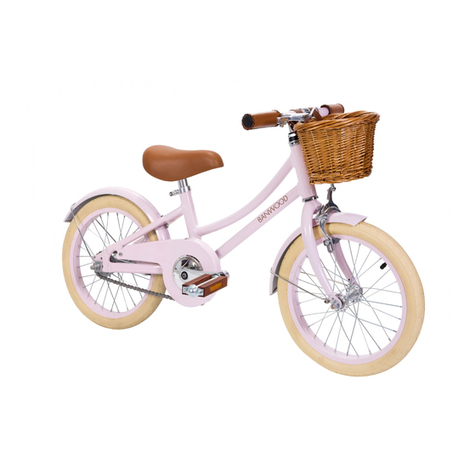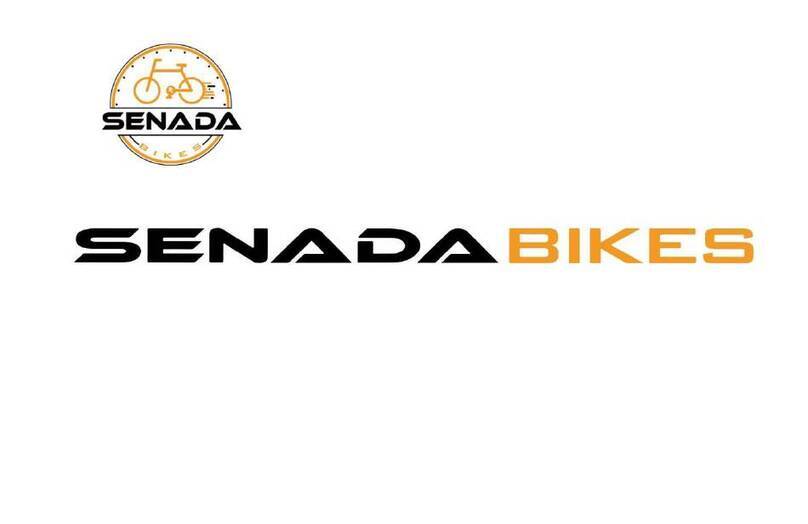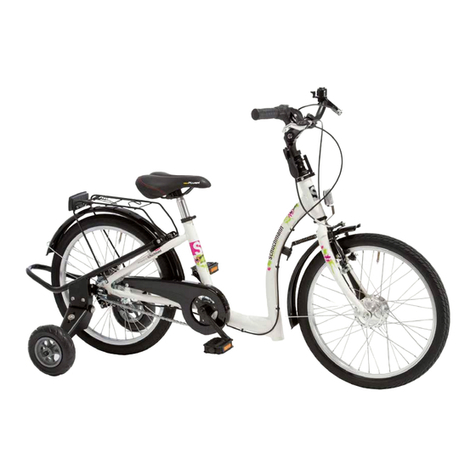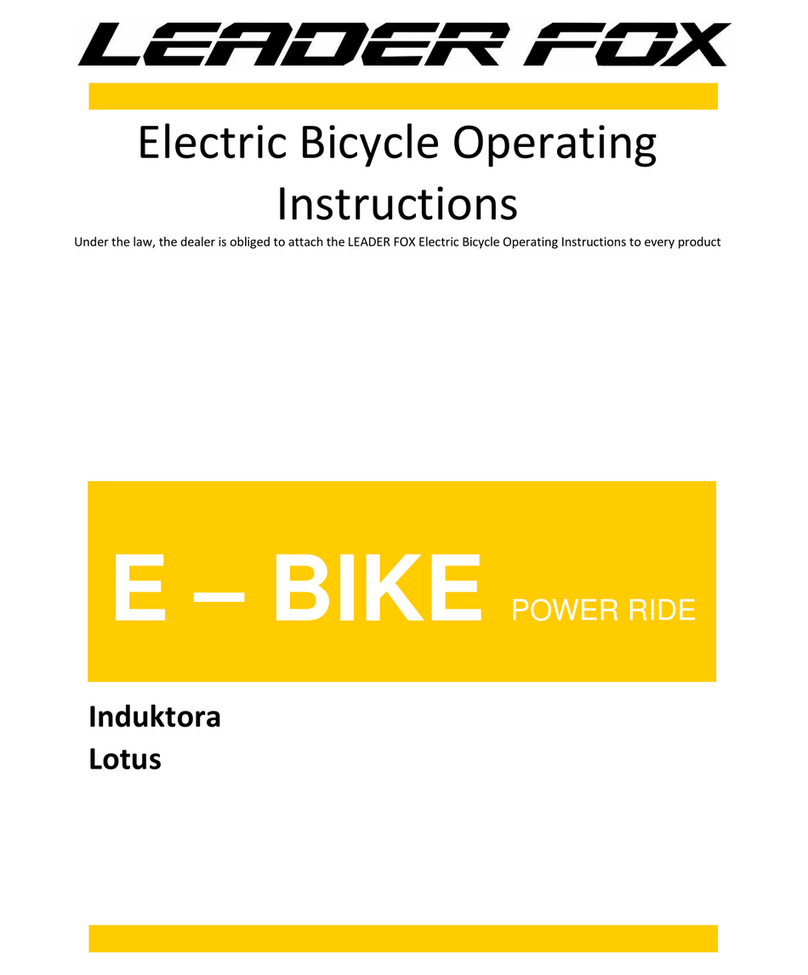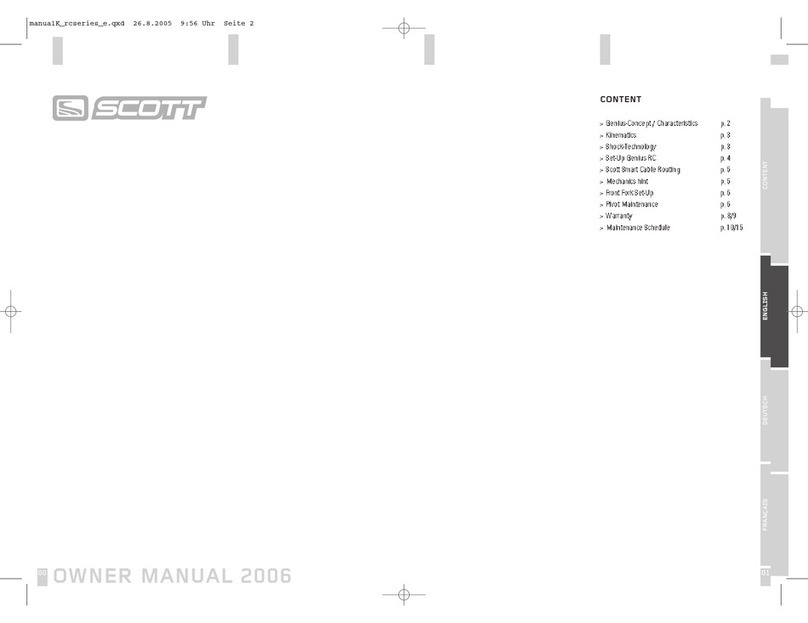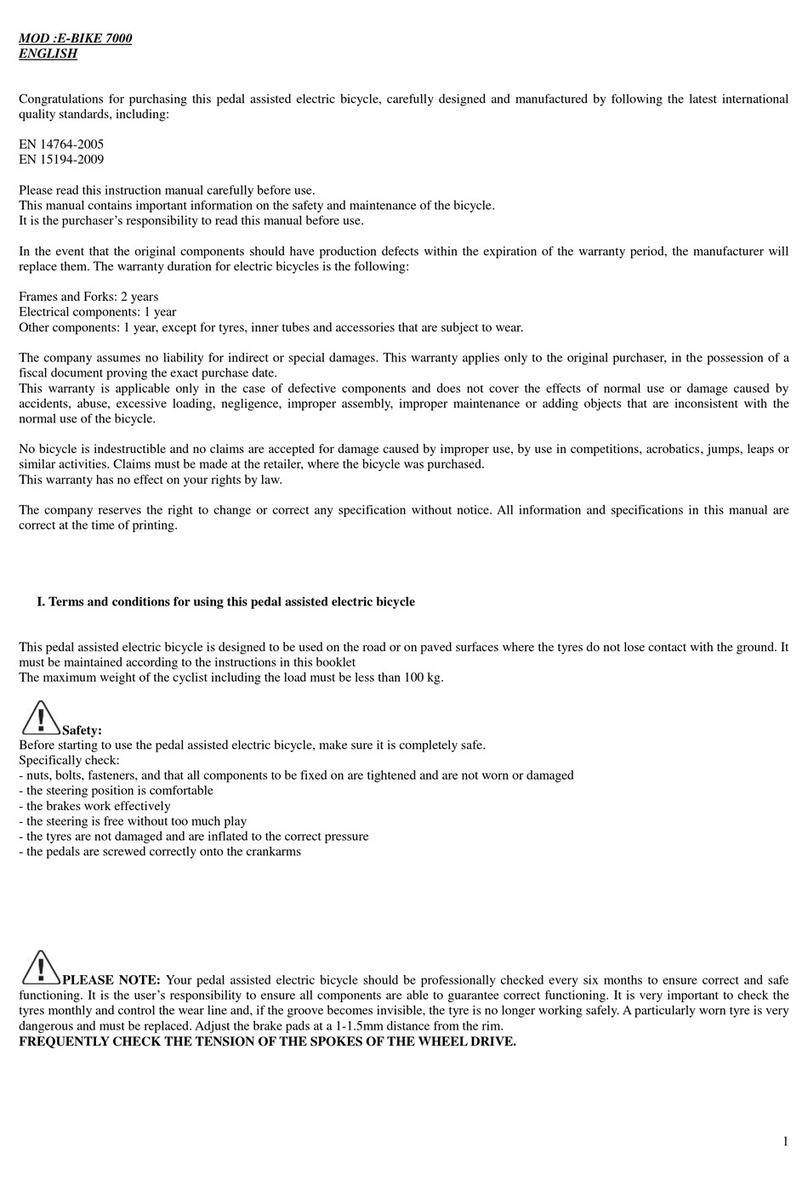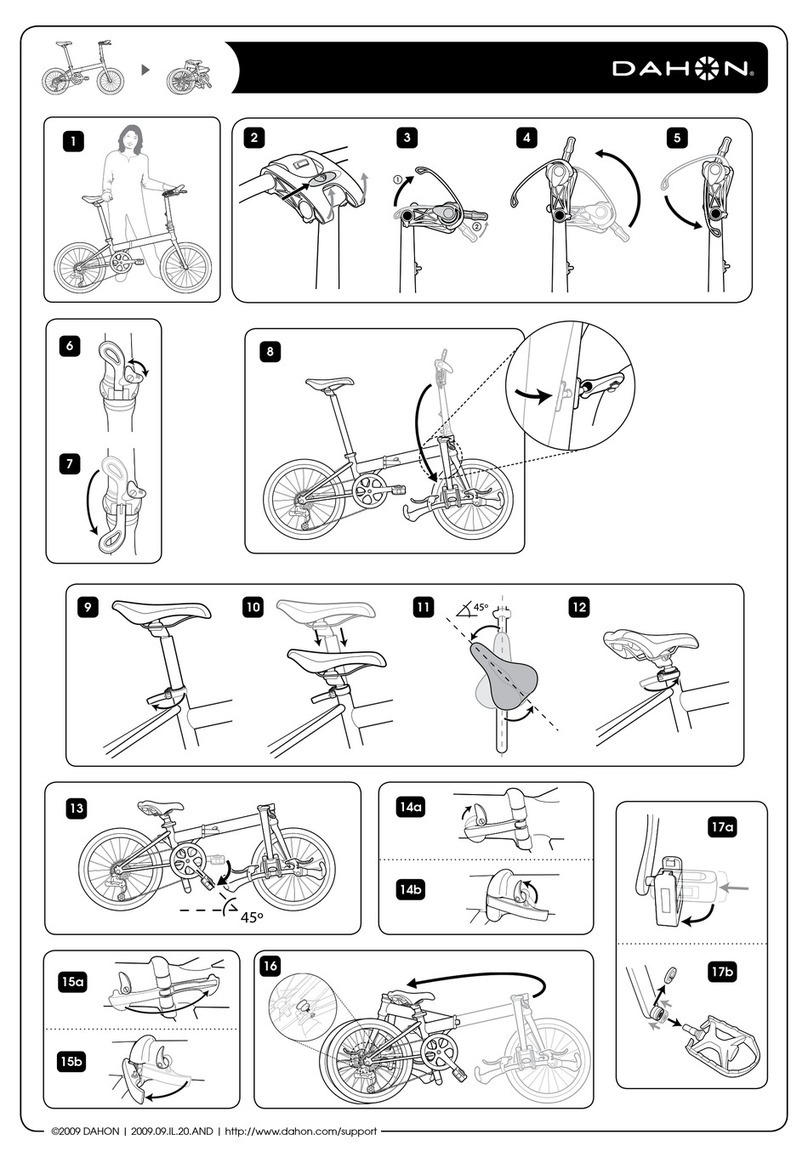Creme Caferacer Guide


2
BICYCLE MANUAL&WARRANTY
1. WARNINGS AND IMPORTANT INFORMATION.
1.1 WARNING: Some of the service procedures require specialist tools and
good mechanical skills. Therefore to minimize the risk of serious or even fatal
accidents, always conduct all the mechanical work on your bike in a profes-
sional bike shop.
1.2 IMPORTANT NOTICE: This manual is not intended as a comprehensive
use, service, repair or maintenance manual. Please consult your dealer for all
service, repairs or maintenance. Your dealer may also be able to refer you to
classes, clinics or books on bicycle use, service, repair or maintenance.
1.3 WARNING: The bike box contains instructions for components made by
third parties. You must study these carefully and follow the directions before
riding your bike.
1.4 IMPORTANT NOTICE: Before starting the rst ride, make sure you know
all the trafc regulations and the requirements for items such as lights and
reectors and that all the necessary equipment has been installed on your
bicycle. Always follow all local bicycle laws and regulations.
1.5 INFORMATION: The maximum load on the rack is 8kg on the front and
20kg for the rear. Note that mounting heavy objects on racks, especially on
the front, will signicantly change the steering characteristics of your bike. It is
advised to take some time to get used to the bike with a loaded rack by riding
it rst on a side road or empty parking lot before going on the street. Always
make sure that your luggage is properly fastened to the rack!
1.6 INFORMATION: The maximum load of the rider and luggage is 100kg.
1.7 WARNING: Never carry anything which obstructs your vision or your com-
plete control of the bicycle, or which could become entangled in the moving
parts of the bicycle.
1.8 NOTE: The bicycle you have just purchased is designed for riding on
a paved surface where the tires do not lose ground contact. Using the bicycle
in off-road conditions may lead to severe damage to some of the parts and
may lead to serious accidents.
1.9 WARNING: The stem’s minimum insertion mark must not be visible above
the top of the headset. If the stem is extended beyond the minimum insertion
mark the whole steering system may fail and cause you to lose control of the
bicycle. This may result in injury and death.

3
BICYCLE MANUAL&WARRANTY
1.10 WARNING: Do not extend the seat post above the minimum insertion
mark.
1.11 WARNING: Alloy handlebars should be replaced at least once a year be-
cause the can snap suddenly with no warning if submitted to fatigue stress for
a prolonged period of time.
1.12 Take extra care and attention when mounting the front rack on the Cafer-
acer bicycles.
2. GENERAL RIDING INFORMATION
2.1 Riding a bicycle can be dangerous. You must keep this in mind and be cau-
tions at all times, especially when riding in trafc.
2.2 See and be seen. Use lights in low light conditions.
2.3 Always wear a helmet when riding. It can save your life.
2.4 Always conduct a pre-ride check (detailed information can be found fur-
ther in this manual).
2.5 Never ride the bicycle if you observe any technical problems or have any
doubts about the proper functioning of any elements in the bicycle.
2.6 Keep the bike clean and well maintained.
2.7 Carry a pump, spare inner tube, patch kit, and a basic tool kit- you may
need this in the case of a at tire of other common mechanical problem that
is usually easy to x if you have the right tools. Ask your dealer for advice on
this issue.
2.8 If your bicycle is equipped with gears, you can choose a gear combina-
tion that is most comfortable for the riding conditions. Gears will allows you
to maintain a constant rate of pedalling. Use lower gears for going up hill
and higher gears for going downhill. You should stop pedalling for a moment
when you make each gear change. Ask your dealer to give you more advice
on this issue.
2.9. Be careful with the brakes - they can be powerful and if activated too ag-
gressively, can cause you to crash. You should spend some time to get a feel of
the brakes on a side road or empty parking lot before going on public roads.

4
BICYCLE MANUAL&WARRANTY
2.10 Use your bell to signal your approach to pedestrians and other cyclists.
2.11 Avoid riding too fast, especially down hill. It is easy to loose control of the
bicycle and crash at high speeds, and also you will nd it very difcult to slow
down especially if the hill is steep. Avoid riding over ruts and potholes. Do not
try to ride up curbs.
2.12 Protect your bike from theft. Purchase a lock and never leave your bike
unlocked while unattended, even if you are planning to be away from it for just
a few minutes.
3. TECHNICAL INFORMATION
Make yourself familiar with the names of all the main parts of the bicycle by
studying the diagram below:
1/ frame, 2/ fork, 3/ rims, 4/ tires, 5/ front rack, 6/ rear rack, 7/ brakes (for
Vinyl and Caferacer), 8/ brake lever, 9/ handlebars, 10/ headset, 11/ stem,
12/ pedals, 13/ cranks, 14/ chain, 15/ hubs (with brakes for Holymoly), 16/
seat binder, 17/ seat post
4. ASSEMBLY OF THE NEW BICYCLE
This should always be carried out by the dealer where you purchased your

5
BICYCLE MANUAL&WARRANTY
bicycle. If you buy a bicycle that is disassembled, or only partially assembled
the warranty will be void. It should be done in your presence, in order to make
the necessary adjustments correctly, such as saddle height, handlebar angle
and stem height. It is also important to note that even if the bicycle is built
up perfectly when new, it will need some additional adjustments a few weeks
(or around 50km) later. You should visit your dealer and ask him to check the
bicycle for you after this period. This is essential to keep your warranty.
5. PRE-RIDE CHECK
Before every ride you should always make a pre-ride check. It should include
the following points:
5.1 Clean the frame and fork and examine them CAREFULLY for any signs of
cracks or other defects. If anything suspicious is found, contact your local bike
dealer for a proper inspection. DO NOT RIDE THE BICYCLE IF IT YOU SEE
ANY DEFECTS IN THE FRAME AND FORK.
5.2 Check if the brakes are working properly by testing their efciency in
a parking lot or on a side road. When the brake is applied, the distance from
the brake lever to the handlebar should be bigger than 3cm. Check the brake
pads too - you should replace damaged and worn out elements and adjust im-
mediately when improper function is noticed. To do this, contact your dealer
or the closest authorized bike service. Remember that improper setup of the
brake can cause serious injury or death. Follow the brake manufacturers in-
structions closely for setup and maintenance. The instructions are supplied
in the box with every bicycle. If you are in doubt about their correct function,
contact your local bicycle shop.
5.3 If your bicycle has rim brakes, inspect the rim walls to check if they are not
excessively worn out by the brakes. A groove made by manufacturer on the
sidewall of a rim should always be visible. On rims without a groove it is im-
portant to check if the braking surface has not become deformed by the brake
pads. The rims should be replaced periodically whenever a visible deformation
of the rim surface occurs.
5.4 Check the connection between the handlebars and stem. Try pushing the
handlebars up and down - there should be no movement between these two
elements. If there is any, it is necessary to tighten the stem bolt (FIG 1) using
around 14Nm of torque.
5.5 Check the connection between the stem and the fork. With the front tire

6
BICYCLE MANUAL&WARRANTY
between your legs try turning the handlebars left and right - the relative posi-
tion of the stem, handlebar and fork should stay the same. If any movement is
noticed, tighten the steer tube bolt (FIG 2) using 16 Nm of torque. Never ride
a bicycle with a loose stem or bar as this may cause fatal accidents.
5.6 Check the headset for play (stand next to the bicycle, apply the front brake
and push forwards and backwards. There should be no play between the frame
and fork). If any play is found contact your local bike shop. Do not attempt to
make any adjustments yourself.
5.7 Check if the pedals are properly threaded into the cranks. If not, use
a 15mm wrench to secure them with a torque of 15Nm.
5.8 Check if the wheels are straight (lift the bike and spin each wheel - the rim
should not move more than around 1mm to each side). Check if al the spokes
are tight by running your hand around each wheel on both sides. Contact your
bicycle dealer to resolve any problems. Do not attempt to ride a bicycle with
wheels that are not straight, as it is a dangerous to your health and life.
5.9 Check if the tires are properly inated (see the prints on the side walls for
instructions about the optimum pressure). Use a proper bicycle pump with
a pressure gauge to achieve the correct pressure. Check the overall conditions
of the tires, if they are damaged, torn or worn out you should replace them
before riding.
5.10 Check wheel axle to fork connection - this is critical for your safety. If
you have axle nuts they should be tightened according to the manufacturer’s
specication. If you have a quick release make sure that it is set to the CLOSED
position, and that there is a reasonable amount of resistance when pushing the
lever. The amount of resistance can be adjusted by turning the knob on the
opposite side of the lever when the lever is in the open position. Never leave
the quick release loose, and do not try to turn it like a screw.
5.11 Make sure all the bolts that hold carriers, racks and fenders to the frame
and fork are tight. If in doubt, contact your dealer to check it for you.
5.12 Check the brake cables and their housing for kinks, rust, broken strands,
or frayed ends. If you notice any damage, you should ask a bicycle shop to
replace the cables immediately. Damaged cables can seriously impede brak-
ing efciency.
If any problems are found during the pre-ride check you should immedi-
ately seek professional advice from a bicycle mechanic. Do not ride the
bicycle until all problems have been resolved. Riding a bicycle with any

7
BICYCLE MANUAL&WARRANTY
6. ADJUSTMENTS
It is possible to make some adjustments to your bicycle that will inuence
your riding position. These adjustments can make a great difference to riding
pleasure, speed and safety - so unless you are a very competent cyclist and
mechanic, do not attempt to execute any of these adjustments yourself. Seek
advice at your local bicycle shop. The basic adjustment points are as below:
6.1 Adjusting saddle height. This should be carried out using an 5 mm hex
wrench. Unscrew the seat binder bolt, set the saddle at a certain height, then
re-tighten the bolt and sit on the bicycle. Repeat until you nd the best posi-
tion. The tightening torque of the seat binder should be around 12Nm. When
adjusting saddle height never extend the seat post above the warning sign
that is printed on the post. Check FIG 1. A general rule for performance riding
is that the saddle height should be set so that when you are seated and place
the heel of your foot on the pedal in it’s lowest position, your leg should be
almost straight. However, for comfort riding you should not follow this rule -
the saddle should actually by quite a bit lower.
WARNING: Never extend the seat post above the minimum insertion
mark that can be found on the lower part of the seat post!
FIG 1: Adjusting saddle height
6.2 Adjusting the saddle position. This should be done using a 6mm hex
wrench. When you loosen this bolt, it is possible to change the angle of the
saddle and it’s fore and aft position FIG 2. Try experimenting with various
combinations. A general rule is that the saddle should be set more or less in
the central position, and should be tilted slightly to the rear (the nose should

8
BICYCLE MANUAL&WARRANTY
be pointing up around 3 -5 degrees). This will put more body weight on the
saddle and take of some pressure from your hands.
FIG 2: Adjusting saddle position
6.3 Adjusting the handlebar angle and stem position. This can be done through
adjusting the stem height and handlebar angle. Riding position is a thing
of personal preference and it’s best to ask your dealer to help you nd the
best geometry for you. To adjust the stem height and handlebar position use
a 6mm hex wrench or 13mm at wrench (this depends on which model of bi-
cycle you have). FIG 3, FIG 4. Unscrew the stem bolt, set the stem at a certain
height, then re-tighten the bold and sit on the bicycle. Then try experimenting
with the handlebar position - unscrew the handlebar bolt in the stem, set the
handlebar to a certain position, re-tighten the bolt and sit on the bicycle. Re-
peat until you nd the best combination of stem height and handlebar angle.
The tightening torque of the steer tube bolt in the stem should be 16Nm. The
tightening torque of the h-bar bolt in the stem should be 14Nm. A general
rule for adjusting the handlebars is: lower = faster, higher = more comfortable.
WARNING: Never extend the stem above the minimum insertion mark
that can be found on the lower part of the stem’s shaft!

9
BICYCLE MANUAL&WARRANTY
FIG 3: Adjusting handlebar angle
FIG 4: Adjusting stem height
6.4 Tightening torque for various bolts on the bicycle.
Stem steer tube bolt – 16 Nm
Stem handlebar bolts – 14 Nm
Front hub axle bolt– 17 Nm (for 10mm axle hubs)
Rear wheel bolt– 29 Nm
Crank to bottom bracket bolts – 40 Nm
Seat binder: 12 Nm
Bolds in seat post clamp: M5: 15Nm, M6: 20Nm, 13mm or 14mm nut: 25Nm
Pedals: 10Nm

10
BICYCLE MANUAL&WARRANTY
Correct tightening force on fasteners, nuts, bolts, screws on your bicycle is
crucial. Too little force, and the fastener may not hold securely. Too much
force, and the fastener can strip threads, stretch, deform or break. Either way,
incorrect tightening force can result in component failure, which can cause you
to loose control and fall.
7. MAINTENANCE AND PERIODICAL CHECKS.
Take care of your bicycle, and you will enjoy it for a longer time. Also take
some time to periodically inspect the bicycle in more detail - this is important
for your safety. Here is some basic information.
7.1 A good rust inhibitor should be applied to the inside of your frame at least
once a year. Regular cleaning will remove salt and other chemicals from the
surface of your bicycle minimizing the likelihood of external corrosion. It is very
important that paint chips and scratches get touched up as soon as possible
with factory touch-up paint or nail polish. Prior to painting, make sure that the
surface is free of rust, clean and dry. The frame does not require any lubrica-
tion with the exception of the inside of the seat tube.
7.2 Bicycles with hand polished rims are supplied with a rubbing compound.
You can use this periodically on a soft cloth to keep your rims shiny.
7.3 Keep your chain cleaned and lubed. This is especially important if you ride
often in wet conditions. Use proper bicycle chain lubricants, WD-40 is not one
of them!
7.4 Periodically check hubs for play and have the bearings adjusted if nec-
essary by professional bicycle mechanic. The bearings should be lubricated
about once a year.
7.5 Check the cranks for play (hold the bike with one hand, and the pedals with
the other and look for play by trying to push the pedals from one side of the
bike to the other). If any play is found contact your local bike shop.

11
BICYCLE MANUAL&WARRANTY
8. IMPORTANT SAFETY INFORMATION FOR ASSEMBLY AND USE
OF FRONT CAFERACER CARRIER
8.1 This Crème Caferacer carrier MUST be mounted by a professional bicycle
workshop, strictly according to the instructions in this leaet. Failing to do so
can result in a serious accident caused by the rack blocking the front wheel!
8.2 This front carrier is designed only for Crème Caferacer Bikes and cannot be
used with any other bicycle.
8.3 The maximum load capacity of Crème Caferacer front carrier is 10 kg. This
load cannot be exceeded under any circumstances !
8.4 The Crème Caferacer front carrier was not designed for child-seat attach-
ment and it is not suitable to mount one.
8.5 The Crème Caferacer front carrier mounting bolts should be checked fre-
quently. If any bolts are loose or missing, you must stop riding the bicycle
immediately.
8.6 It is forbidden under any circumstances to modify Crème Caferacer front
carrier.
8.7 Please make sure that any luggage tted to Crème Caferacer front rack is
securely tted in accordance with the manufacturer instructions and there are
no loose straps that can get caught in any of the wheels.
8.8 Advice – any reectors/lamps attached to the Crème Caferacer front rack
shouldn’t be obscured when luggage is attached.
8.9 Advice – please distribute luggage evenly between the two sides of the
luggage carrier.

12
BICYCLE MANUAL&WARRANTY
9. FRONT RACK MOUNTING PROCEDURE.
9.1 STEP 1: Identify all the components of the front rack.
1/ left stay, 2/ right stay, 3/ main tray, 4/ lamp, 5/ nuts, 6/ front bolts
7/ safety strip
9.2 STEP 2: Remove the 4 bolts that come threaded into the side of the front
fork.
7

13
BICYCLE MANUAL&WARRANTY
9.3 STEP 3: Assemble the front rack as shown on the photographs. The bolts
connecting the side stays with the main tray should be tightnened using two
tools with a torque of 7 Nm.
9.4 STEP 4: Apply Loctite (or other thread locking compound) to 2 bolts and
fasten the bottom legs of the rack to the fork like so:
Do not tighten the bolts yet !

14
BICYCLE MANUAL&WARRANTY
9.5 STEP 5: Dismount the front caliper brake from the fork crown, slide the
fender mount off the bolt, then slide the safety strip onto the caliper bolt, like
on the attached photo.
9.6 STEP 6: Wrap the strip around the rack, and return to the caliper bolt.
Then slide the fender mount back onto the caliper bolt. Like so:
9.7 STEP 7: Put the caliper back into the fork crown, (make sure that the front
fender eyelet is also mounted on the caliper bolt) and tighten the mounting
bolt. Make sure Loctite (or other thread locking compound is used).

15
BICYCLE MANUAL&WARRANTY
9.8 STEP 8: Align the rack so that you can mount the two top bolts. Before you
thread them into the fork, make sure they are coated with Loctite (or other
thread locking compound). In this position, the safety strip should be slack,
not very tight.
9.9 STEP 9: Tighten the 4 mounting bolts that secure the rack to the fork (indi-
cated by the black arrows) with a force of 7 Nm. Make sure that a spring washer
is moutned under each bolt head, as on the photo below

16
BICYCLE MANUAL&WARRANTY
WARRANTY
1. Creme S.C. warrants all it’s new bicycles against defects in materials and
workmanship for a period of 2 years.
2. If any defects are noticed in the bicycle, the Customer must stop using the
product immediately and should report this to the Dealer within 14 days. Us-
ing a damaged bicycles will void the warranty, lead to more extensive damage
and may pose a serious hazard to the rider’s health and life.
3. The warranty period starts from the day when the product is purchased.
This purchase must be documented with the cash receipt plus lled in war-
ranty card (which includes the following information: date of purchase, serial
number of frame, name of bike model, customers name and name of dealer).
4. The warranty applies only to the original owner and is not transferable.
5. Claims under this warranty should be made through the dealer where the
bicycle was purchased.
6. The bicycle should be submitted to a mandatory check-up between the 3rd
and 5th week from date of purchase (or after 50km of riding) to an authorized
bicycle dealer. The conrmation of this check-up should be documented in the
warranty card. Failure to do this will void the warranty.
7. The warranty is valid only if the bicycle is sold by an authorized dealer in
a ready-to-ride condition.
8. If a certain part of the bicycles will require replacement under this warranty,
parts that are similar in function to the originals shall be provided. It may not
always be possible to provide parts that are identical. The decision if a broken
part requires replacement or repair will be made by the dealer.
9. The warranty does not cover normal wear and tear of tires, chains, brake
pads, bearings, cogs and chainrings. Wheel truing, lubricating, brake adjust-
ment, drive train adjustment and other typical maintenance procedures are
not covered by the warranty and must be conducted by a professional bicycle
workshop at the cost of the Customer.
10. The warranty does not cover:
- labour charges for replacing parts,
- paint and decals,
- problems that result from excessive loads occurring during extreme riding or
from incorrect riding technique.

17
BICYCLE MANUAL&WARRANTY
11. This warranty is void if:
- the warranty card is lled in incorrectly or incompletely,
- any modications have been made to the bicycle by the customer,
- damage has been caused by external parts that have been incorrectly as-
sembled on the bicycle,
- the product had not been used, maintained or repaired according the the
manufacturers instructions,
- the bicycle had been sold disassembled, or only partially assembled,
- the product was transferred to any third party.
12. Directions on how to deal with warranty cases shall be provided by the
distributor of the product in the region where it was purchased.

18
BICYCLE MANUAL&WARRANTY
PROOF OF PURCHASE – WARRANTY CARD
Dealer’s stamp
Bike, model : ......................................................................................................
Frame serial number : ........................................................................................
Fork serial number (if any) : ................................................................................
Price: ..................................................................................................................
Date of purchase : ..............................................................................................
I certify that I am acquainted with the actual specication of the bicycle (this
can be slightly different than that published by the distributor).
Buyer’s signature: ...............................................................................................
Dealer’s signature: .............................................................................................
Table of contents
Other Creme Bicycle manuals
